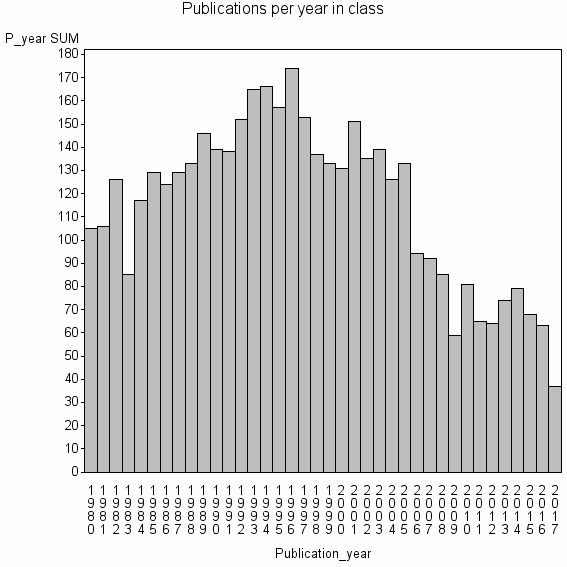
Class information for: |
Basic class information |

Hierarchy of classes |
The table includes all classes above and classes immediately below the current class. |
| Cluster id | Level | Cluster label | #P |
|---|---|---|---|
| 8 | 4 | POLYMER SCIENCE//CHEMISTRY, PHYSICAL//MATERIALS SCIENCE, MULTIDISCIPLINARY | 1554940 |
| 172 | 3 | POLYMER SCIENCE//HYDROGEL//MACROMOLECULES | 59074 |
| 2421 | 2 | POLYMER SCIENCE//RUBBER ELASTICITY//OID SCI | 4390 |
| 6881 | 1 | RUBBER ELASTICITY//POLYMER SCI TECHNOL GRP//MODEL NETWORKS | 1459 |
| 11907 | 1 | MACROMOLECULAR THEORY AND SIMULATIONS//BRANCHING DENSITY DISTRIBUTION//NONLINEAR POLYMERIZATION | 973 |
| 16164 | 1 | OID SCI//KSP RD D637//SECT TISSUE BIOPHYS BIOMIMET | 696 |
| 18861 | 1 | SIO2 SUSPENSION//SOL GEL TRANSITION//GEL POINT | 556 |
| 22710 | 1 | FAST TRANSIENT FLUORESCENCE//FAST TRANSIENT FLUORESCENCE TECHNIQUE//STEADY STATE FLUORESCENCE TECHNIQUE | 393 |
| 25121 | 1 | BIOL MAT SCI DENT//3 FIBER METHOD//AIBN COMPLEXES | 313 |
Terms with highest relevance score |
| rank | Category | termType | chi_square | shrOfCwithTerm | shrOfTermInClass | termInClass |
|---|---|---|---|---|---|---|
| 1 | POLYMER SCIENCE | WoSSC | 128281 | 64% | 1% | 2793 |
| 2 | RUBBER ELASTICITY | authKW | 107672 | 1% | 37% | 41 |
| 3 | OID SCI | address | 103334 | 1% | 60% | 24 |
| 4 | MACROMOLECULAR THEORY AND SIMULATIONS | journal | 90515 | 3% | 9% | 134 |
| 5 | GEL POINT | authKW | 83727 | 1% | 28% | 41 |
| 6 | MODEL NETWORKS | authKW | 76548 | 0% | 67% | 16 |
| 7 | POLYMER SCI TECHNOL GRP | address | 69280 | 1% | 37% | 26 |
| 8 | MACROMOLECULES | journal | 67267 | 14% | 2% | 605 |
| 9 | BRANCHING DENSITY DISTRIBUTION | authKW | 43959 | 0% | 88% | 7 |
| 10 | FAST TRANSIENT FLUORESCENCE | authKW | 43064 | 0% | 100% | 6 |
Web of Science journal categories |
| chi_square_rank | Category | chi_square | shrOfCwithTerm | shrOfTermInClass | termInClass |
|---|---|---|---|---|---|
| 1 | Polymer Science | 128281 | 64% | 1% | 2793 |
| 2 | Engineering, Chemical | 1281 | 8% | 0% | 373 |
| 3 | Physics, Atomic, Molecular & Chemical | 529 | 6% | 0% | 246 |
| 4 | Chemistry, Physical | 485 | 10% | 0% | 449 |
| 5 | Mechanics | 175 | 3% | 0% | 144 |
| 6 | Physics, Mathematical | 154 | 2% | 0% | 104 |
| 7 | Physics, Multidisciplinary | 149 | 4% | 0% | 196 |
| 8 | Materials Science, Composites | 94 | 1% | 0% | 39 |
| 9 | Physics, Fluids & Plasmas | 78 | 2% | 0% | 70 |
| 10 | Chemistry, Multidisciplinary | 40 | 5% | 0% | 236 |
Address terms |
| chi_square_rank | term | chi_square | shrOfCwithTerm | shrOfTermInClass | termInClass |
|---|---|---|---|---|---|
| 1 | OID SCI | 103334 | 1% | 60% | 24 |
| 2 | POLYMER SCI TECHNOL GRP | 69280 | 1% | 37% | 26 |
| 3 | KSP RD D637 | 35887 | 0% | 100% | 5 |
| 4 | SECT TISSUE BIOPHYS BIOMIMET | 30474 | 1% | 17% | 25 |
| 5 | POLYMER PROD TECHNOL CHEM ENGN | 22966 | 0% | 80% | 4 |
| 6 | CHEM ENGN POLYMER PROD TECHNOL | 21532 | 0% | 100% | 3 |
| 7 | CNRS SPE OMETRIE PHYS BP 87 | 21532 | 0% | 100% | 3 |
| 8 | BIOL MAT SCI DENT | 18363 | 0% | 32% | 8 |
| 9 | EXPT POLYMER PHYS GRP | 16402 | 0% | 57% | 4 |
| 10 | INTEGRAT MED BIOPHYS | 14687 | 0% | 10% | 20 |
Journals |
| chi_square_rank | term | chi_square | shrOfCwithTerm | shrOfTermInClass | termInClass |
|---|---|---|---|---|---|
| 1 | MACROMOLECULAR THEORY AND SIMULATIONS | 90515 | 3% | 9% | 134 |
| 2 | MACROMOLECULES | 67267 | 14% | 2% | 605 |
| 3 | POLYMER GELS AND NETWORKS | 25637 | 1% | 15% | 24 |
| 4 | POLYMER | 22548 | 7% | 1% | 291 |
| 5 | MAKROMOLEKULARE CHEMIE-MACROMOLECULAR SYMPOSIA | 16451 | 1% | 4% | 62 |
| 6 | JOURNAL OF POLYMER SCIENCE PART B-POLYMER PHYSICS | 12387 | 3% | 1% | 126 |
| 7 | MACROMOLECULAR REACTION ENGINEERING | 11970 | 1% | 6% | 29 |
| 8 | POLYMER BULLETIN | 10145 | 2% | 1% | 102 |
| 9 | VYSOKOMOLEKULYARNYE SOEDINENIYA SERIYA A | 10070 | 2% | 2% | 79 |
| 10 | MACROMOLECULAR SYMPOSIA | 9713 | 2% | 2% | 80 |
Author Key Words |
Core articles |
The table includes core articles in the class. The following variables is taken into account for the relevance score of an article in a cluster c: (1) Number of references referring to publications in the class. (2) Share of total number of active references referring to publications in the class. (3) Age of the article. New articles get higher score than old articles. (4) Citation rate, normalized to year. |
Classes with closest relation at Level 2 |